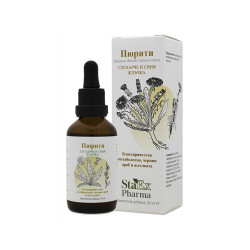Chicory
Cichorium inthibus L.
Other names: blue daisy, blue dandelion, blue sailors, blue, weed, bunk, coffeeweed.
Description:
Chicory is a perennial herb. The stem is erect, covered with hairs or bare. It is branched at the top. 20-100 cm high. The basal leaves are collected in a rosette of short stalks, lanceolate, cut to lobes. The stem leaves are sessile with rounded or arrow-shaped ears covering the stem. They are 7-30 cm long, 1-12 cm wide. The flowers are light blue, sometimes white or pink. Flower baskets are single or several, on short stalks or without stalks - sitting in the axils of the leaves. It blooms June-October. The fruits are ovoid, 2-3 mm long with a kite of short scales. The root is long, fleshy, spindle-shaped, thickened, brown. In cultivated plants, the root can be in the form of a large root crop.
Distribution:
The botanical Latin name "Cichorium" is associated with its distribution and comes from the Greek words "kio" - walk and "chorion" - field. It grows in the plains, foothills and mountains, on dry grassy places, along roads and railways, like a weed in the fields with cultivated crops. In the wild, chicory is widespread throughout Europe - its homeland, in North America, China and Australia, where it is naturalized. In Bulgaria it grows everywhere, up to 1000 - 1500 m above sea level.
In many countries, chicory is grown and distributed as a cultivated plant because of the leaves, which are consumed raw in salads and because of the roots, which are used as a good substitute for coffee. Productive varieties have been created, the most popular of which are: "red chicory" - grown mainly in Italy; "Sugar chicory" - it has tightly gathered leaves, resembling lettuce; "Belgian endive" - grown in the Netherlands, Spain, Britain and France, where it is called "white leaf". Chicory is also grown in the United States and Russia, although not as much. Belgium exports a white leaf to over 40 different countries. France is the largest producer of cultivated chicory.
Composition:
The roots of wild chicory contain up to 40% inulin, and the cultivars - up to 68% (in dry matter). The roots also contain sugars, proteins, fats and soluble fiber. This makes them a good food product. The roots also contain the unique glycoside intibin, unique to this genus, as well as other biologically active substances.
The leaves and stems are especially rich in vitamins. In addition to vitamin C, vitamin E, vitamin K and vitamin PP, they contain almost all B vitamins - B1, B2, B3, B5, B6 and B9 (respectively - thiamine, riboflavin, niacin, pantothenic acid, folic acid). The leaves contain minerals - salts of sodium, potassium, magnesium, calcium, iron, phosphorus; sugars, proteins, etc. They also contain biologically active sesquiterpene lactones (lactucine and lacucopicrin), the bitter alcohol taraxasterol, and chicoric acid. The flowers contain the coumarin glucoside cicorinin. The seeds contain fat, starch and a protocatechin aldehyde.
Healing properties:
The medicinal use of chicory has been known since ancient times. In the Middle Ages and today chicory is grown and used as a remedy in the Catholic monasteries of Europe.
Bulgarian folk medicine uses chicory in many cases of diseases and illnesses. It is most often used to stimulate appetite and improve the function of the stomach and intestines in gastritis, enteritis and colitis. Chicory has a choleretic and diuretic effect and is used in diseases of the liver (jaundice, cirrhosis), bladder and kidneys.
Chicory is also used: to treat edema of cardiac origin, with increased nervous excitability, hysteria and hypochondria; as a laxative, to lower blood sugar in diabetes, hemorrhoids, gout and dizziness, cough and fever, as an anthelmintic. Externally used to treat open wounds, cuts and bruises.
Chicory root coffee:
The roots are cleaned, washed, cut into pieces and dried in a ventilated place until they become crispy, then baked in a strong oven until they turn brown. After cooling, grind in a coffee grinder. Chicory coffee is stored and prepared as regular coffee.






